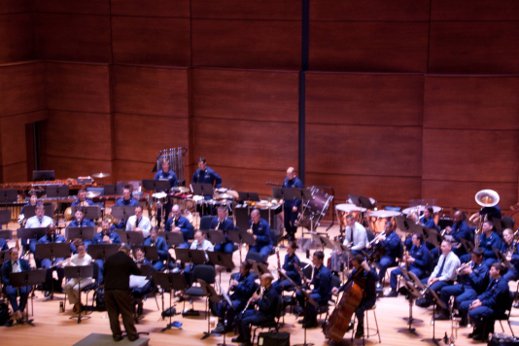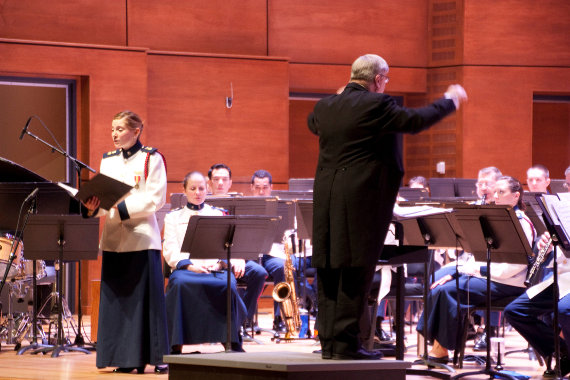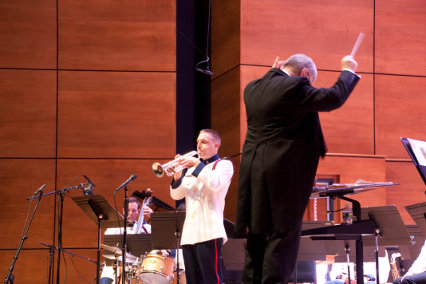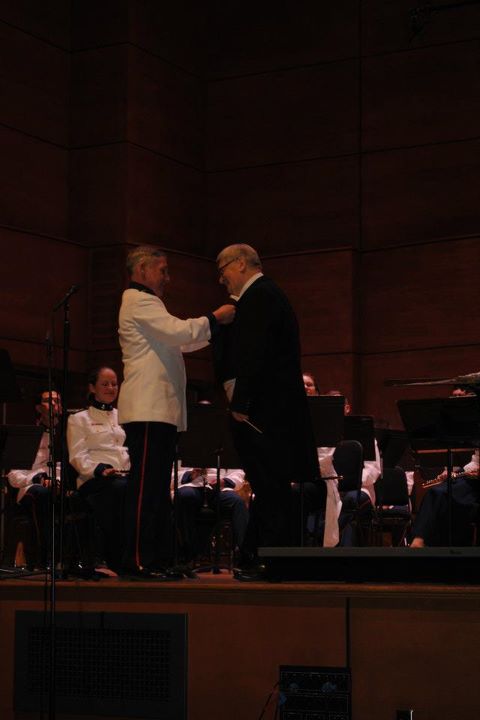
CONCERT OF THE MONTH
The US Coast Guard Band is arguably the Vienna Philharmonic of the wind world. How do I back up this ridiculously extravagant claim?

February’s Concert of the Month has to be the one I conducted with the U S Coast Guard Band; this was quite easily one of the greatest musical experiences of my life with one of the best musical ensembles in the world. I have never encountered a group with so many fine soloists in each section, so many musical personalities all competing and contributing, in short an ideal group for making chamber music at the highest level, which is ideally what wind music is about. Our programme was:
US Coast Guard Band Conductor Tim Reynish
Sunday 12th February 2012, Leamy Hall, USCG Academy, New London Connecticut
| Masque | Kenneth Hesketh | |
| King Pomade Second Suite | Ranki Georgy | |
| Five Folk Songs | Bernard Gilmore | |
| Suite of English Dances | Ernest Tomlinson | |
| Intermission | ||
| Concertango | Luis Serrano Alarcon | |
| Elegy for Miles Davis | Richard Rodney Bennett | |
| Dances from Crete | Adam Gorb | |
| March | Marcel Wengler |
I had heard on the grapevine that the US Coast Guard Band was America’s best kept secret, and that its playing at present rivals that of any other ensemble. A week spent with them in New London, Connecticut, convinced me that they are better than that, they are quite the best. I have spent many a sleepless night since the beginning of February, trying to analyse what are the musical ingredients of a great ensemble at the top of its game.
First, in the wind ensemble there is absolutely no hiding place, every player must be in complete technical control of his or her instrument. Here is an ensemble of young players, graduates of the top American conservatoires and universities, Juilliard, Rice, North Western, Florida State, University of Michigan, University of Kentucky. Many sections alternate players, so that there is real strength throughout, in tutti work there is a natural automatic internal balance, the kind of instrumental balance which you find only in the greatest orchestras, there of course aided by that wonderful cloud of strings. Rhythmic precision is a given, intonation is normally perfect, phrasing natural and musical, they play with a great dynamic range, and even the biggest moments never get noisy and “bandy”; this was really chamber music making of the highest order with everyone contributing. Of course in the wind ensemble, everybody is potentially a soloist, and here again the USCG scores in spades, since there are a number of huge musical personalities, playing with perfect balance in tuttis, but waiting to seize their chance of a solo.

There are louder and faster performances of Masque by Kenneth Hesketh out there, some of them on YouTube, but to my ears none is so clean with so much detail in evidence, with such an easy swing between compound and simple time signatures, and with such clarity of diction. I think that we tend in wind and brass bands play all dynamics the same regardless of whether the forte or fortissimo is the first in the work or the last, whether the chord is a climax of a passage, whether or not it has greater harmonic significance, whether it is simply an accompagnato. The US Coast Guard Band have an immediate sensitivity to these points, so that their performances have more light and shade than we normally hear with a band.
I fell in love with King Pomade some time ago when conducting in Budapest; the late Ranki Gyorgy was a very amusing man who could transmit his sense of humour to music, rare. This second suite is an arrangement from the orchestral ballet suite, here scored for a big wind band, but when played by the Coast Guard Band, even the biggest moments are always played with clarity and a fine balance. Throughout he writes with a welcome freshness and spontaneity, with lots of solo opportunities, and more than a few echoes of Kodaly and Bartok. At present the work is out of print, but it’s a masterpiece that we need access to.

Years ago I came across a wonderfully transparent score by Bernard Gilmore of his Five Folk Songs, fell in love with them and eventually was able to publish them. Like the Ranki they are charming and amusing, and so thinly scored that they are like chamber music, reminiscent of the Berio Folk Songs a work with which they share a range of texts in different languages. Here, whether English, Greek, Spanish or Yiddish, they were given winning and well-characterised performances by Megan Weikleenget; recently she was a mother for the first time, and I cannot imagine that her young son Luke could resist her singing of Gilmore’s Lullaby.
The first half was completed by another masterpiece of folk music, Ernest Tomlinson’s Suite of English Folk Dances. When I was a young horn player back in the sixties this was a staple diet for most light music programmes, and I especially enjoyed playing Dick’s Maggot when it comes scored for horn trio. Thirty years ago I invited Ernest to score the work for wind band, and eventually he did; the result is a suite of six great tunes, expertly scored, again great fun.

When discussing the programme last summer, I was advised by Commander Kenneth Megan and his assistant Richard Wyman, that many of the band are equally adept at both straight and jazz, so this gave me the chance to programme two of my favourite concertante works, Alarcon’s Concertango with solo saxophone, and Richard Rodney Bennett’s evocative Elegy for Miles Davis from the trumpet concerto, Greg Case and Tom Brown as the fine soloists with wonderful backing from the soloists in the band.

Our final work was another of my favourite commissions, Dances from Crete by Adam Gorb. The spotlight is turned onto so many soloists, and in this performance everything was despatched with ease and a virtuoso nonchalance. Being made an Honorary US Coast Guard at the end of the concert was the greatest honour.